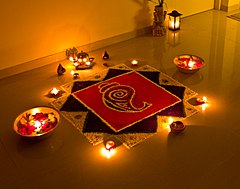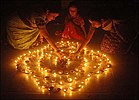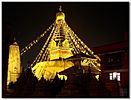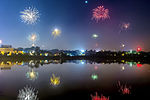Dwali
| Diwali / Deepavali | |
|---|---|

Rangoli decorations, made using coloured powder or sand, are popular during Diwali.
|
|
| Also called | Deepavali |
| Observed by | Hindus, Sikhs, Jains and Newar Buddhists |
| Type | Cultural, seasonal, religious |
| Celebrations | Diya and lighting, home decoration, shopping, fireworks, puja (prayers), gifts, performing religious rituals, feast and sweets |
| Begins | Dhanteras, two days before Diwali |
| Ends | Bhai Dooj, two days after Diwali |
| Date | Varies per Hindu calendar |
| 2017 date | 19 October (Thursday) 18 October (Wednesday) in South India & Singapore |
| Related to | Kali Puja, Galungan, Diwali (Jainism), Bandi Chhor Divas, Tihar, Swanti |
Diwali festivities include a celebration of sights, sounds, arts and flavors. The festivities vary between different regions.
|
|||||||||
Diwali or Deepavali is the Hindu festival of lights celebrated every year in autumn in the northern hemisphere (spring in southern hemisphere). It is an official holiday in Fiji, Guyana, India,Malaysia, Mauritius, Myanmar, Nepal, Singapore, Sri Lanka, Suriname, and Trinidad and Tobago. On the island of Jamaica, it is celebrated proudly by the Indo-Jamaican community, however in 2010 it was inaugurated as an official yearly event at the historic Devon House residence for the first time, in an effort to celebrate the country's Indian heritage on a national level. One of the most popular festivals of Hinduism, it spiritually signifies the victory of light over darkness, good over evil, knowledge over ignorance, and hope over despair. Its celebration includes millions of lights shining on housetops, outside doors and windows, around temples and other buildings in the communities and countries where it is observed. The festival preparations and rituals typically extend over four to six day period. The word Diwali is used by some communities to mean all the festivities while others think of it as one festival night on the no moon day of the Hindu Lunisolar month Kartika in Bikram Sambat calendar (the month of Aippasi in Tamil Calendar). In the Gregorian calendar, Diwali falls in mid-October and mid-November.
Before Diwali, people clean, renovate, and decorate their homes and offices. During Diwali, people dress up in new clothes or their best outfits, light up diyas (lamps and candles) inside and outside their home, participate in family puja (prayers) to Lakshmi – the goddess of prosperity, light fireworks, engage in family feasts, sharing mithai (sweets), and exchange of gifts between family members and close friends. Diwali also marks a major shopping period in nations where it is celebrated.
...
Wikipedia








